This post may contain affiliate links. We may receive a small commission, at no cost to you, if you make a purchase. Read Disclosure.
If you plan on traveling a trip to Australia, but you’re on a strict budget, then this guide is for you. Although Australia is an expensive country to travel in, it can be done in more affordable ways, you just need to know how.
Although Australia is our home, we also spent 1.5 years road tripping the country, and learned how to travel in Australia on a budget.
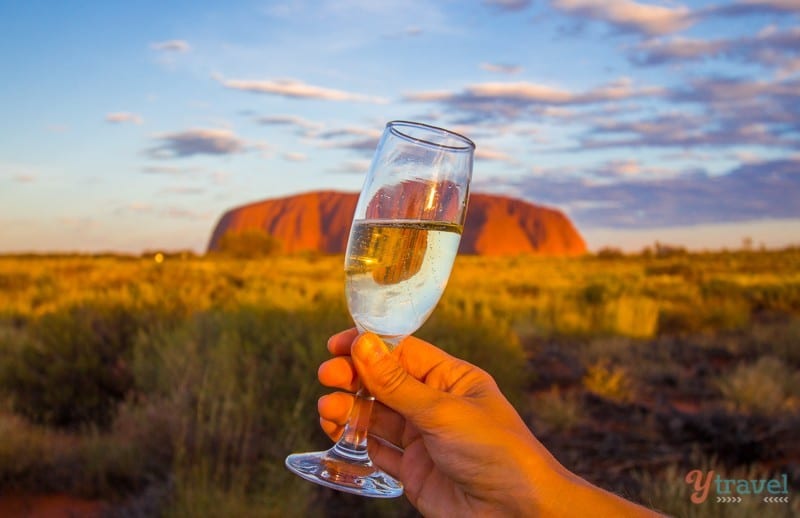
I hate to shatter your dreams of endless Great Barrier Reef scuba dives and glasses of champagne whilst watching an Uluru sunset, so we hope the following Australia budget travel tips will help.
If you want to know how much you should set aside for travel expenses, this is a complete guide to cost of travel in Australia, whereas this guide will focus soley on budgeting tips.
Today we hope to help you lower your costs on your trip down under.
- How to Travel Australia on a Budget
- 1. Plan Your Itinerary First
- 2. Think About Getting Around Australia
- How To Save on Accommodation in Australia
- Ways To Save Money On Eating in Australia
- Drinking on a budget in Australia
- How To Save on Activities and Entertainment on a budget in Australia
- Visit the City Parks
- Visit the Beaches in Australia
- Go for Coastal walks in Australia
- Get A National Parks Pass in Australia
- Visit the Markets
- Get Free Entry to Museums & Galleries
- See the Wildlife in Australia on a Road Trip
- Take Free Walking Tours in Australia
- Look Out For Free Festivals & Events
- Look for Low-Cost Tours
- More Australia Budget Tips
- Final Thoughts on How to Visit Australia on a Budget
- Save It On Pinterest
- Tours of Australia
How to Travel Australia on a Budget
Below we have listed our top considerations and tips for traveling Australia on the cheap.
1. Plan Your Itinerary First
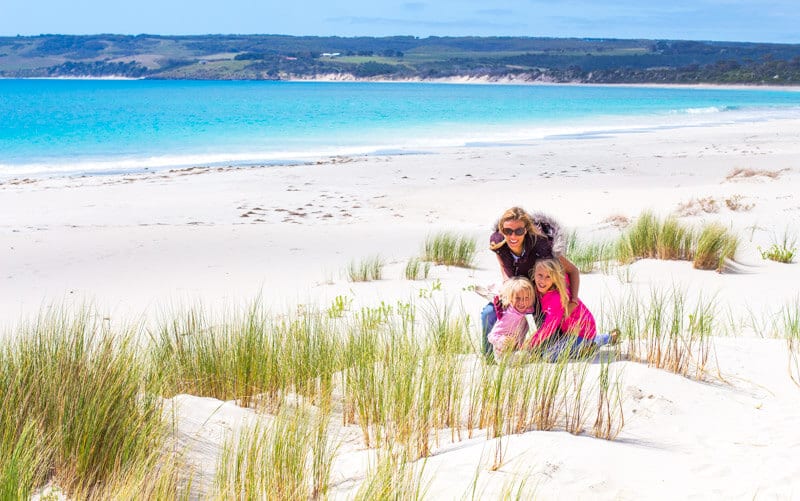
Firstly, let’s put Australia into perspective. Before you can plan how to cut costs, you do really need to put your itinerary together first.
If you don’t plan your itinerary and how to get around first, you will find that two weeks in Australia could end up being the same amount you would spend in an entire month.
When you’re putting together your itinerary, remember the actual size of Australia and it’s landscape, which many travelers disregard until they arrive, and end up regretting the choices they made in the planning stage.
Australia is the sixth biggest country in the world and about the same size as mainland USA. So, considering the country is so vast, the problem becomes how to visit Australia and where to visit?
Think about how much time you have and then make a list of your must-see places in Australia and plan accordingly.
If you only have one week and you’re on a budget, it would be best to focus on one or two regions.
You don’t want to be traveling from Sydney to Perth then back to Cairns in that time. You and your bank balance will be wiped out.
If you have three or four weeks, check out our 3-week itinerary for Australia which has detailed tips on where to go and what to see and do.
But, if you have an extended period of time, more than one month, you’ll have more flexibility and strategies you can use. Let’s dive in.
2. Think About Getting Around Australia
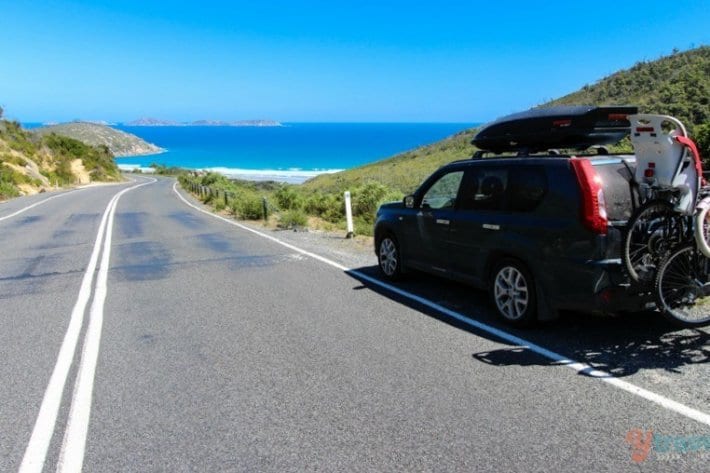
The vast majority of your budget is going to be transport and accommodation. How you get around will vastly depend on how much time you have and where you want to go.
Here are some things to consider when planning your transportation on a budget.
How To Fly Around Australia On A Budget
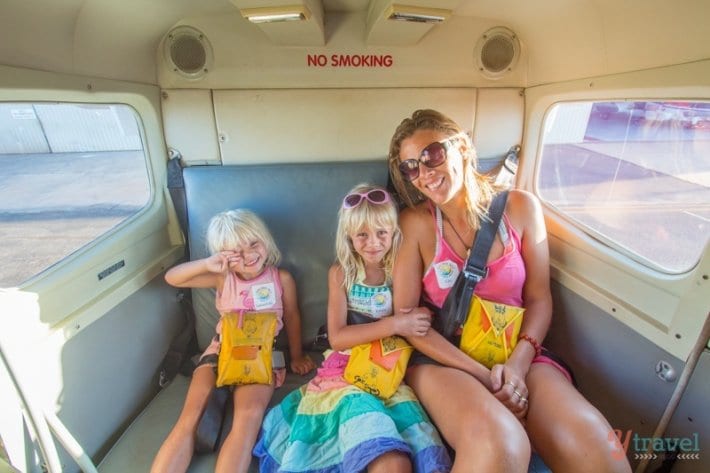
Once you get here, Australia is the land of long distances and for so long we only had two airlines, Qantas and Virgin, so there was a lack of competition and prices were high.
Thankfully, air travel is getting more competitive and cheaper.
Virgin and Jetstar are the two main domestic carriers to consider. Bonza Airlines is a new low cost airline in Australia servicing domestic and regional routes in Australia.
Rex Airline has a backpacker pass available only to international travellers, which gives you one or two months of unlimited Rex Air Travel. Rex flies to regional areas such as Broken Hill, Kangaroo Island, King Island and Coober Pedy.
When searching for flight deals in Australia we always start with Skyscanner which is a comparison website that searches thousands of flights. Once you find your best deal, you book directly through the airline or agent (no extra fees).
Also, read our in-depth post 21 ways to find cheap flights online for extra tips!
Whilst we’re on the subject of flights, if there are three or more of you traveling to an airport, it will probably be cheaper to share a taxi than the train link.
You can also find cheaper deals 5-6 weeks in advance, or very last minute if you’re lucky.
Top tip: Jetstar has a Friday Frenzy deal where you can snap up a flight sometimes for as low as $19. The flight route changes each week and the competition is fierce, though.
How To Drive Around Australia On A Budget
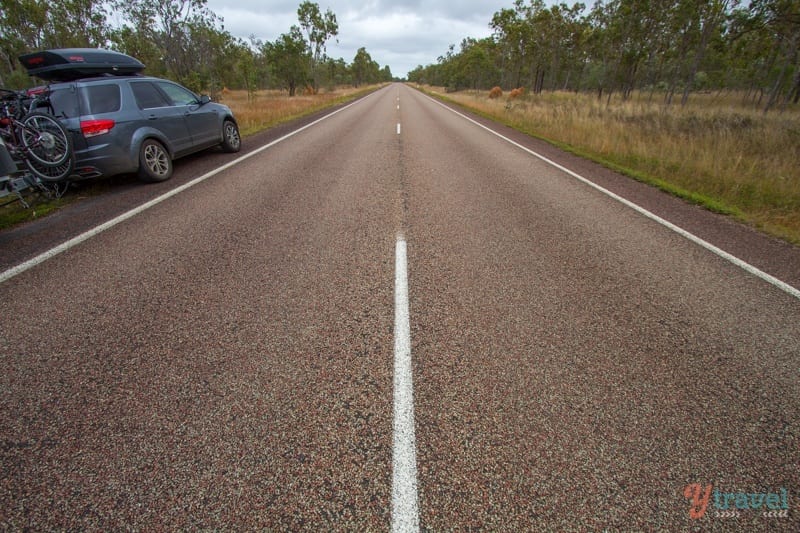
Fuel is expensive and the price will vary from state to state and region to region.
In the Northern Territory, which is the most expensive territory for fuel, costs up to $2 per litre for diesel, but you will pay less on the coast.
If you’re driving around Australia long-term, the best way to travel Australia by car on a budget is to fill your car with friends instead and split the costs.
Check Coles and Woolworths supermarket receipts (dockets). If you spend a certain amount, you’ll get fuel discount coupons, which will save you from 4 – 8 cents a litre.
This can add up especially when driving often and long distances.
Top tip: According to MotorMouth, Tuesdays and Wednesdays are the cheapest days to top up on fuel. Avoid buying it on the weekends, especially if a public holiday! Here are some more handy driving tips for Australia.
FUEL SAVING TIPS:
- Remove excess weight from your vehicle to increase your fuel economy.
- Stay in central locations where you can walk to places and don’t have to rely on your car constantly.
- Plan your routes – don’t back track on long drives and avoid congested areas in big cities.
- Use air conditioning sparingly in the summer.
- Maintain your vehicle – get it serviced and check that your tyres are at the right pressure.
- Drive at a steady pace and use the right gears.
Finding Cheap Car Rentals in Australia
DiscoverCars.com is our favorite site for searching rental cars. They compare all the major car rental sites at once to find your best deal.
Just remember, one-way drop offs usually incur a fee so try and plan your flights and trip so that your driving loops back to your original pick-up destination.
Want a campervan? Check out Relocation rentals where you can rent a campervan for as little as $50 a day (remember a campervan is also going to save you on accommodation costs).
You’re given the vehicle, the route, a time frame and sometimes fuel allowance. Basically you are getting a vehicle really cheap to be the delivery guy.
Juicy campervans are popular campervans to rent. We’ve been seeing these bright green vehicles all over Australia. If the backpackers are using them in droves they must be good value.
For families and larger campervans check out Britz, Maui, Apollo Campers who have a large range of inventory.
Another popular RV rental company in Australia is Outdoorsy. It’s the largest & most trusted caravan, campervan and motorhome hire marketplace on the planet.
Basically, it’s the Airbnb of the motorhome world! They have a range of motorhomes and campervans from vintage campers to modern trailers. Plus, they come with up to $1M in insurance coverage.
Remember that with a campervan you will need to pay for campsites, which typically cost around $10-$25 per night.
Driving Your Own Vehicle in Australia
If you plan on staying in Australia a while, consider buying a car instead. You could sell it at the end of your trip and reclaim some of your initial outlay.
Consider a camper trailer like ours below or a caravan, especially for long-term family travel in Australia. It’s a big country, so having a home on wheels is a more economical option.
Hot Tip: If you buy a camper trailer or caravan try and resell it in the north or west of the country as you’ll typically get a higher resale price.
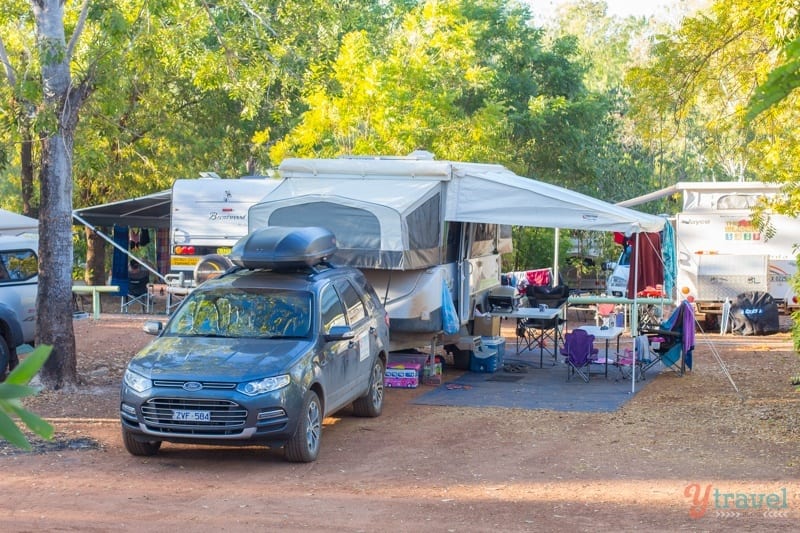
Sites for buying cars include:
- Gumtree.com.au
- CarSales.com.au
- CarPoint.com.au
- AutoTrader.com.au
- CarsGuide.com.au
- TradingPost.com.au
How to Get Around Australia by Bus on a Budget
Buses are a great way to get around inner cities, as well as from major cities, but they are not ideal for visiting national parks or remote locations that are a huge draw for travelers.
If you plan to stay in the city for a week, look to get daily or weekly bus passes.
It’s not the best way to get around Australia, but we know not everyone is able to drive, so if you need to take a bus do research each Australian city for any free public transportation routes before you visit.
For example, Melbourne and Adelaide have free inner city trams and Sydney has a free CBD shuttle (route 555) which runs every 10 minutes on a loop from Central Station to Circular Quay via Elizabeth and George Streets.
Greyhound Australia is a national bus service. We found their buses comfortable and an easy ride. The girls enjoyed it and were pretty well behaved, although the aircon was crap.
Oz Experience operate like Greyhound with the hop-on-hop-off system and have different passes depending on length of trip and areas covered
Premier also has been highly recommended for bus travel in Australia.
We highly recommend against getting the bus from Sydney to Perth. It’s a long journey with nothing much in between. We met someone who did it and then tried to tell us Australia was really boring. Go figure!
How to Get Around by Train in Australia
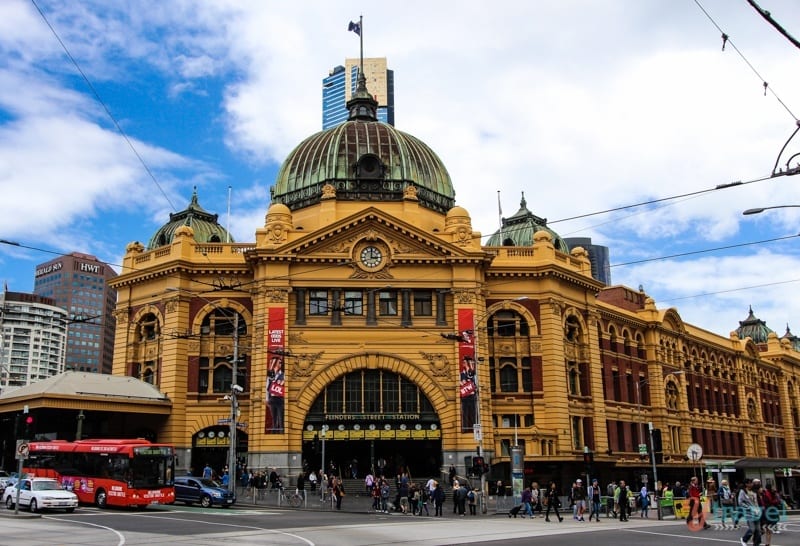
Each city will have it’s own public train system with different prices and deals. For example, Opal is the smartcard ticketing system used to pay for travel on public transport in Sydney, the Blue Mountains, Central Coast, the Hunter Valley and the Illawarra. Add value before you travel and tap on and off to pay your fare. Using an Opal card will save you money and they have cheaper rates on weekends.
The trains will generally move you around cities and to neighboring suburbs and districts. Lines and routes are quite extensive in Sydney and Melbourne and you should have no problem getting to where you need to go anywhere in the cities.
Long distance train travel can be expensive, but you can find rail passes covering the train network across Australia that give you great savings. Rail Passes start at $298.
If you’re planning on traveling long distances over a short period of time, then you might want to consider this, but otherwise we don’t recommend using trains as. a means to travel Australia on a budget.
Some great rail journeys in Australia are the Ghan travelling from Adelaide to Darwin, and the Indian Pacific travelling from Sydney to Perth. These are more tourist attractions that a form of transport, and so tickets are very expensive.
Great Southern Rail, which operates the Ghan and the Indian Pacific has a number of special backpacker fares and low-season discounts if you book in advance.
How To Save on Accommodation in Australia
If you can time your visit right by staying mid-week, you can really save on accommodation in Australia. Especially avoid the big cities over a weekend if possible.
We’re stunned by how much the prices for a bed can rise on the weekend – some places triple.
See our in-depth post ways to save money on accommodation and ways to save money on accommodation in Australia.
Finding Cheap or Free Camping in Australia
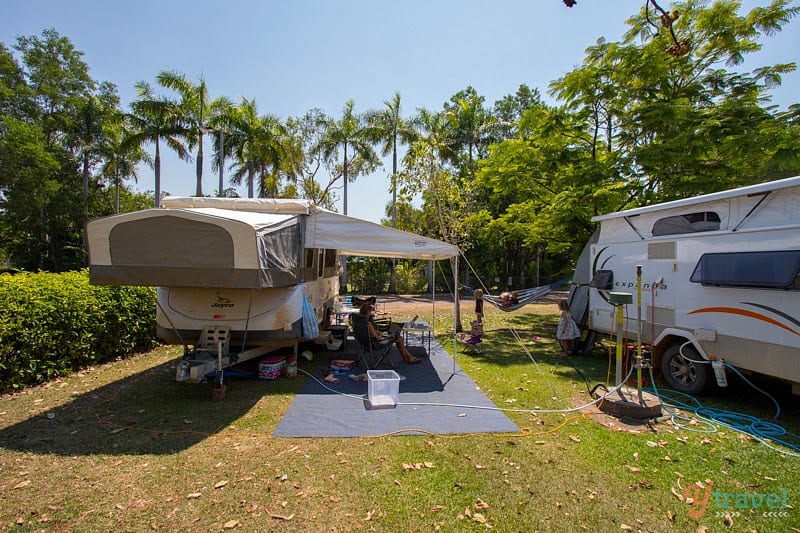
Australia has so many National Parks and many of them you can camp in for free or a small cost. This will involve bush camping.
A night here and there is perfect to help reduce costs. The most popular campsites will have basic amenities – power, toilets, and water.
Caravan Parks are usually clean with fantastic amenities on the beach – the best location in town.
Big4 and Top Tourist Parks are the two main players and have all the amenities and are great for families but very pricey especially during peak holiday periods.
Cost of powered tent sites in caravan parks depend on number of persons and for families they will charge you per child.
Prices start from $35 up to $60 depending on time of season and location. Same goes with powered sites for caravans and camper trailers.
If you’re planning on traveling around Australia in an RV, sign up to the Big4 membership and the Top Tourist Park membership for discounts.
Free Camping is possible at designated camping sites in many locations. They just don’t have the facilities that paid parks have.
We stayed at an awesome free campsite by the river at Gregory Downs in Outback Queensland. Check out ExploreAustralia.net.au for listings.
WikiCamps is a great app, which has a user-generated database of caravan parks and free campsites with user reviews on the features.
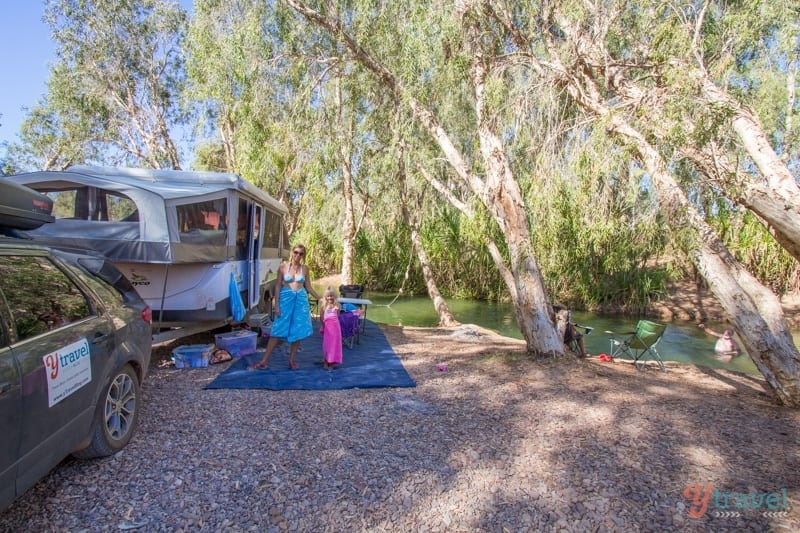
Camping is a great way to meet Australians and for families the best and cheapest way to travel around Australia on a budget.
In Sydney, a great option is to camp on Cockatoo Island on the Harbour. Wake up to views of Sydney Harbour Bridge for about $45 a night. Bargain!
Save Money By Staying in Hostels

Hostels are another cheaper option when it comes to accommodation. A dorm room on average will be $20 to $30 and a private room around $80- $110.
If you are considering a private room then it might make more sense to see if you can get a cheap hotel for around the same price.
There are some hostels that are great for families and have family rooms, which is ideal for those traveling on a budget.
Booking.com is a great search and comparison site that pulls data from all the main hostel websites to help you find the cheapest price.
We’ve stayed in plenty of YHA hostels as they are usually of a high standard and are better for families. Many have family rooms, if not you can book out an entire 4-6 bed dorm to yourself.
We liked the spacious 6-bed dorm we just had to ourselves at Bungalow Bay YHA on Magnetic Island – it came with its own bathroom. AND koalas!! You can have breakfast with them and cuddle them too.
You can also get YHA memberships which give you a 10% discount on accommodation and any tours they offer. Every little bit helps when you travel to Australia.
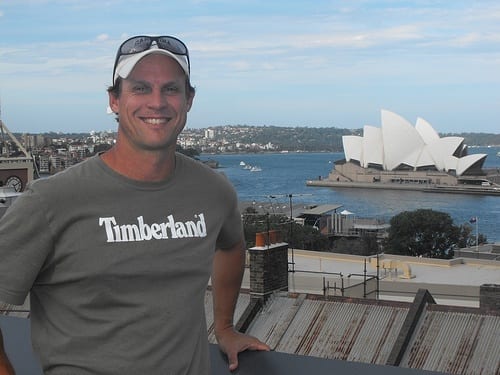
For great views of Sydney Harbour at a third of the price you would pay anywhere else, the Sydney Harbour YHA- The Rocks is definitely the place to stay. Have breakfast on the rooftop with views of the Opera House.
Hostels also have common kitchen areas which is great for saving on meal costs!
How To Save On Apartment Rentals
We love apartments or home rentals when we travel as a family. It gives us a lovely break from our camper trailer or hostels.
It’s a great opportunity for us to all have our own space, catch up on work, do the laundry and cook our own meals in a full kitchen. We need to have that bit of home every now and then.
This is the best option for families or two families sharing. It can also work out to be cheaper than hostels if a group of travellers get together and share.
Again, depending on the location and time of year prices will vary. You can find cheaper deals by staying mid-week, which will be your best bet in the major cities. You might want to book hostels or motels for weekends.
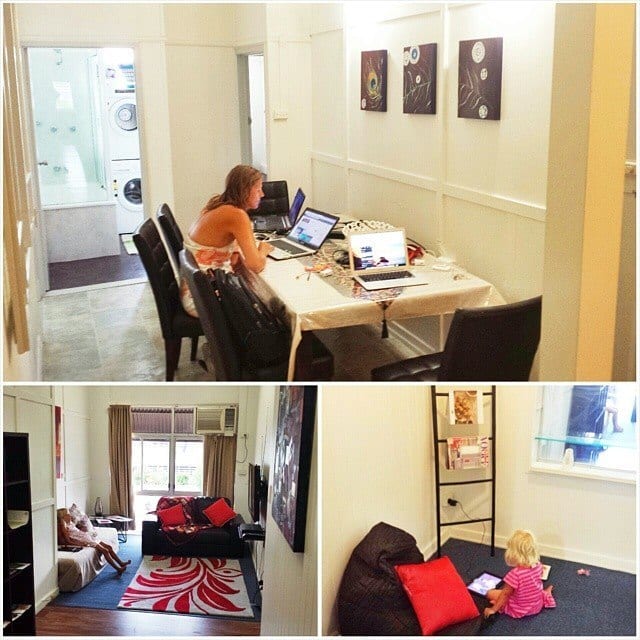
Finding Cheap Hotels in Australia
If you’re looking for a low-cost hotel chain, Travelodge and ibis budget hotels are two chains worth checking out.
We don’t stay in hotels nearly as much as we used to pre-kids, but below are our favorite search sites we use:
- Booking.com
- Hotels.com – sign up to their rewards program (stay 10 nights get 1 night free)
Try House Sitting or House Swapping
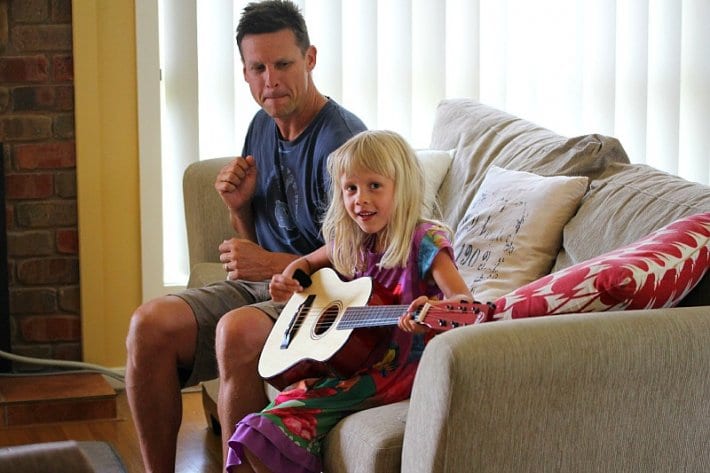
The house sitting strategy has not worked for us as our schedules are never planned more than a week in advance, so we have little flexibility to book things in advance.
That being house sitting is a great way to save money on travel when you’re organized and plan ahead.
Competition is also fierce, though, as more people have cottoned on to this trend.
But if you are super flexible and can travel where the house sits are rather than find a house sit to suit your plans, then it can work very well for you.
For house sitting sites check out:
House swapping is also an option. Try Aussie House Swap or House Swap Holidays.
There is a strategy behind finding the right house sit and beat others to the job. Check out these guides to Housesitting to be ahead of the game.
Ways To Save Money On Eating in Australia
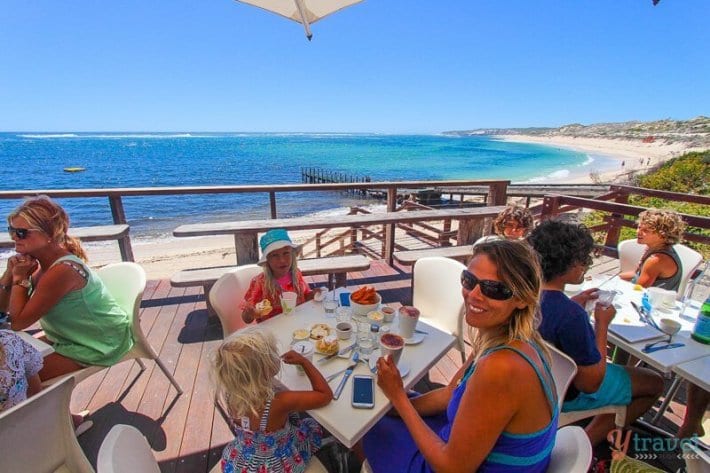
It’s tough to get cheap food in Australia. The majority of your meals will have to come from your own culinary skills.
Be sure to leave room in your budget for the odd meal out as we do have beautiful produce and amazing meals can be found. Don’t miss out on our fresh seafood all around the country.
Below are a few tips for getting cheap eats in Australia.
Finding Cheap Supermarkets
Coles and Woolworths are our competing supermarkets whose love for price wars can really benefit you. Cook your own meals and grab supplies for a picnic rather than eating out.
In smaller regional areas, you’ll find IGA or Foodworks. I prefer IGA. I find their prices are cheaper and often have great specials. They also support local produce suppliers.
Tips For Eating out in Australia on a Budget
If you’re going to eat out often, go for breakfast or lunch instead of dinner – prices will be cheaper.
RSL’s, Memorial Clubs, Bowling Clubs and Surf Clubs – Almost every town in Australia will have at least one of these clubs that have relative cheap food and drink.
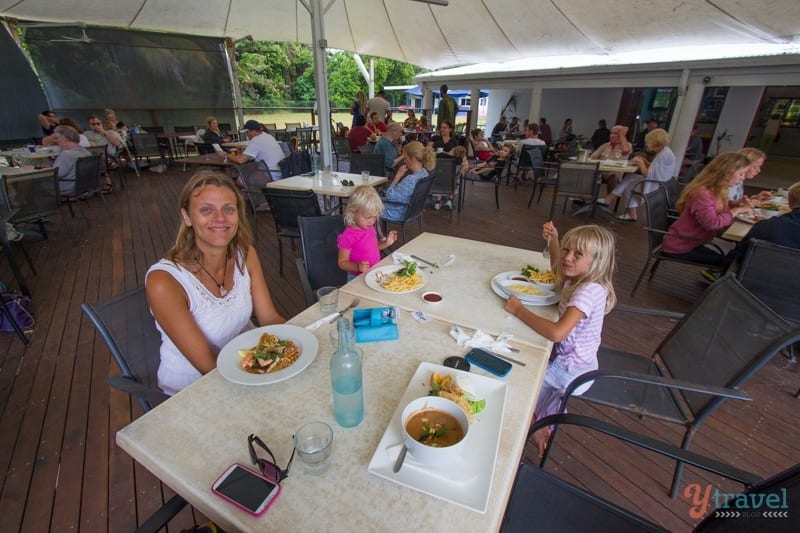
Shopping Malls – Hit the food courts in any of the shopping malls for lunch. They typically have cheaper meals.
Research restaurants in the area carefully, you might be lucky to find a “children eat free” deal. Some of your accommodation may have coupons. Ask the locals for their picks for eating out.
Check the back of your supermarket receipt. You will often find deals for nearby restaurants such as two for one.
Australia has lots of takeaway places (take out). You’ll find them in every town and are mostly Asian, Italian, Greek, fish and chips, bakeries or chicken shops. You will find meals much cheaper here than if you were to eat in.
Menu Log is a great app for finding takeaway deals. This app tells you what restaurants are nearby and who home delivers. It’s on iPhone and Android. Thai, Vietnamese, Chinese and Malaysian food is often still the best value.
And you cannot go wrong with Chinatown in Sydney and Melbourne. It’s where you’ll find cheaper prices and large servings.
Picnics – still one of the best ways to have an economical meal. Take advantage of the beautiful city parks, beaches and foreshores. Lay out a blanket or towel and source your supplies from the supermarket or farmers market and pick up a cheap bottle of wine from the bottle shop!
Eating in – of course cooking your own meals with supplies sourced from the supermarket or farmers markets will save you money. We make self-contained accommodation with a full-kitchen a priority on our travels.
Drinking on a budget in Australia
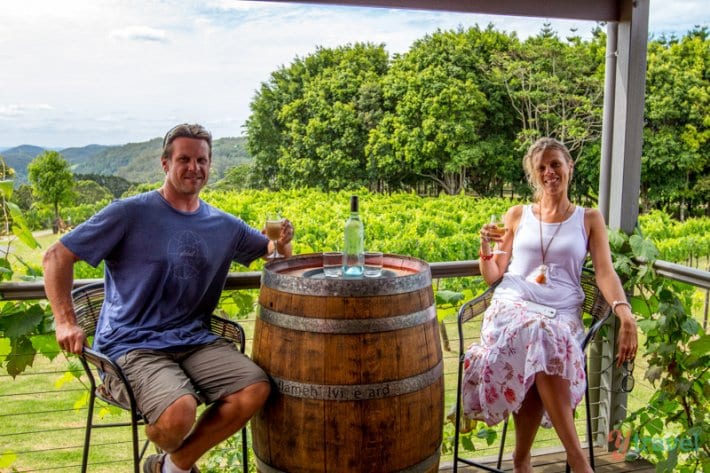
Alcohol will KILL your budget in Australia, especially if you get comfortable at a pub or bar.
Don’t be surprised to get charged up to $12 for a pint of beer in Sydney, Melbourne or Perth. A glass of wine can go for $6-$8.
You should definitely visit some of our iconic pubs, and we have some of the best beer gardens in the world, but if you do look for drink specials and happy hours.
Australia doesn’t’ have much of them, mostly due to our binge drinking laws.
The bottle shop is your best bet for saving money on beer, wine and spirits. The main stores you’ll see around are BWS, Liquorland and Dan Murphy’s.
You can get a decent bottle of wine for $12- $20 from the bottle shop, or if you are game, the old Aussie favourite, the goon, which is basically cask wine.
You can get 4L for about $14. The goon becomes the best friend of many backpackers to Australia.
Check out the back of your supermarket receipts, they often have a buy two bottles of wine for the price of one coupon.
When buying beer from a bottle shop it’s better value to buy a carton of 24 bottles ($48) than a 6 pack for $15. Often they’ll have specials on beer.
My favourite range of beers in Australia is the James Squire range, not sold everywhere. Carlton Dry is also a good local beer at decent prices!
BYO (Bring Your Own) to Restaurants
A lot of restaurants in Australia are BYO. That means you can bring in your own beer or wine, usually for a corkage of $1-2. This will greatly reduce your eating out costs.
Refill Water Bottles
Refill a water bottle at a public bubbler (water fountain) instead of spending $2.50 per bottle of water. Do not drink from any taps marked as ‘bore water’ as it‟s not safe for consumption.
And get yourself a decent bottle you can fill up each morning before leaving your accommodation.
Lay off the soda drinks
Now is the time for you to give up the coke addiction. Again, your best bet is to buy by the box at a supermarket.
Bottom line – drinking is an expense that isn’t very friendly to your Australia on a budget plans. Budget wisely.
How To Save on Activities and Entertainment on a budget in Australia
Lucky for you Australia is an outdoorsy culture with stunning nature, parks, and wildlife.
Visit the City Parks
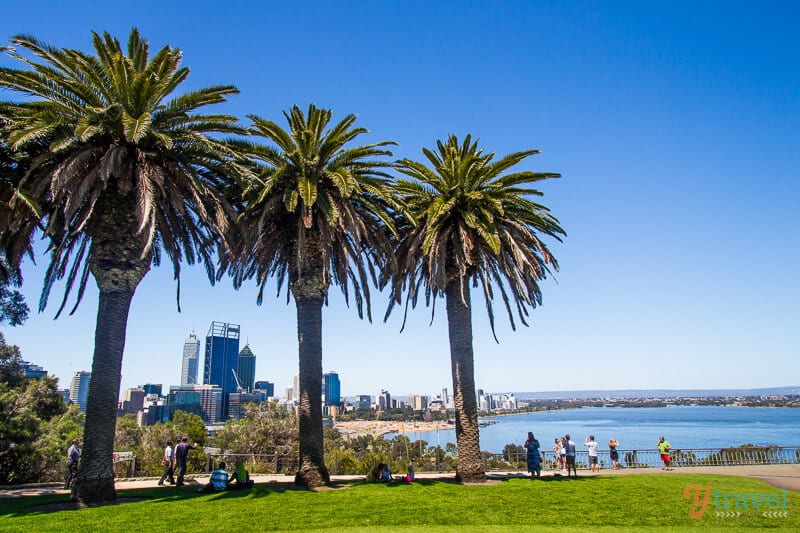
In the major cities, we have some beautiful and free public parks in amazing locations to go for a walk or have a picnic.
- In Sydney don’t miss the Royal Botanic Gardens, The Domain and Hyde Park.
- In Melbourne don’t miss the Botanical Gardens, Carlton Gardens and Fitzroy Gardens.
- Perth’s Kings Park is lovely with stunning views over the river to the city.
All the major cities will have a nice enough park for you to getaway and enjoy some solitude at no cost.
Visit the Beaches in Australia
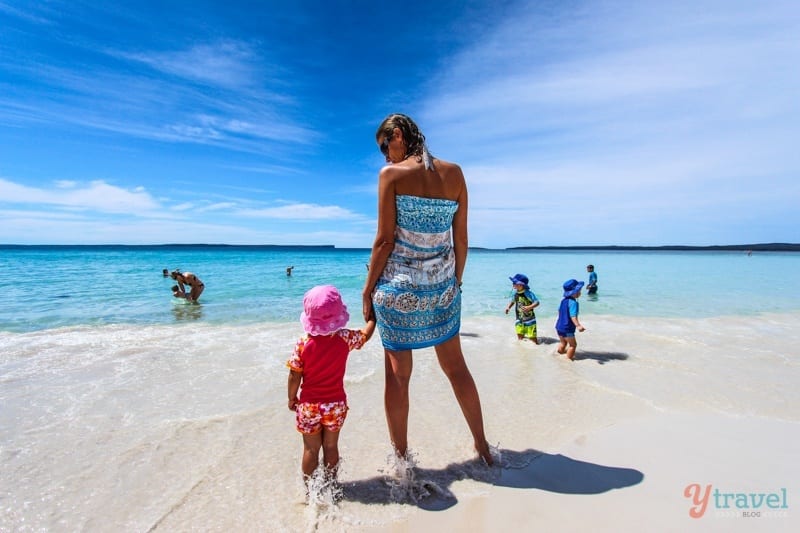
Australia is famous for its beaches. Our coastline stretches almost 50,000 kilometres and is linked by over 10,000 beaches. Spending the day at the beach is what us locals love best and a cheap way to spend your day.
Take a day pack with water, food, sunscreen and your towel. Or make use of the free BBQ facilities. Just make sure you have some gold coins or a credit card for the parking meters!
For tips on some of our favourite beaches check out these posts:
Go for Coastal walks in Australia
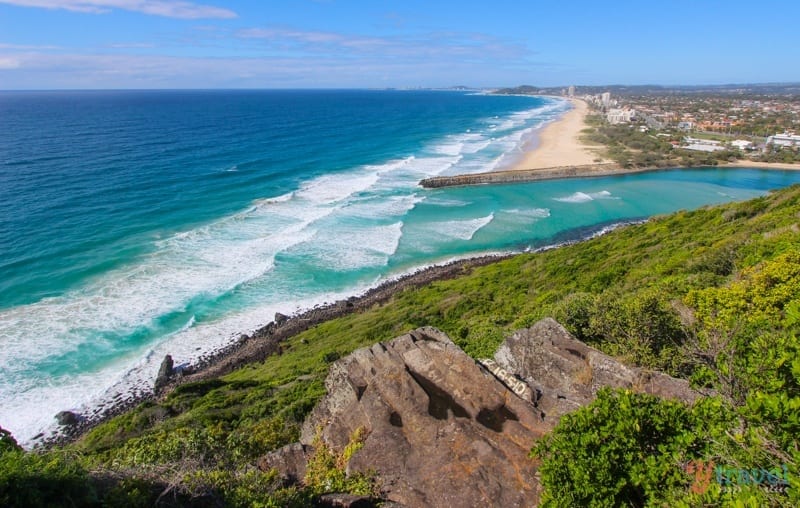
With so many beaches and being an island continent Australia has many stunning coastal walks that won’t cost you a cent. Going for a coastal walk is one of our favorite free activities in Australia.
You can stretch your legs for an hour or half a day. All you need again or some snacks, plenty of water and your camera.
We have plenty of walks left to do but some of our faves so far have been:
- Bondi Beach to Coogee Beach coastal walk
- Byron Bay Lighthouse Walk
- 18 short walks we love in Australia
- 4 walks on the Gold Coast
Get A National Parks Pass in Australia
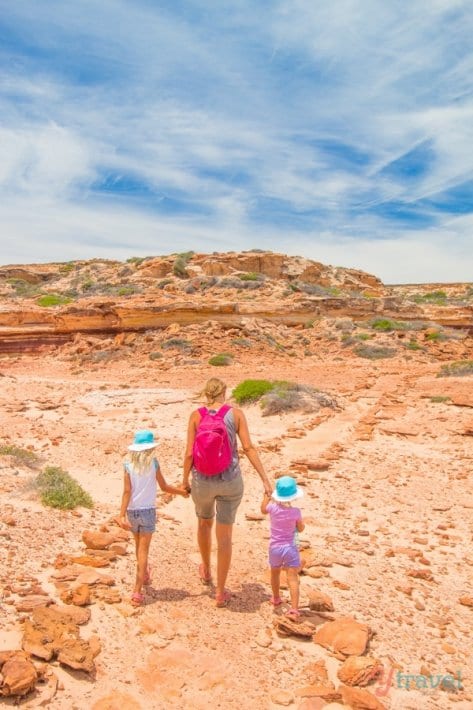
Australia literally has thousands of National Parks, and each one has it’s own entrance fee, so save yourself some money by getting the National Parks Pass. if you plan to visit a few.
Whether you just visit for a day or stay over and go camping our National Parks our a highlight.
Check out our list or 25 National Parks in Australia to set foot in.
Other helpful links:
- NSW National Parks – for pass options click here.
- Queensland National Parks
- Victoria
- South Australia
- Western Australia
- Tasmania
- Northern Territory
Visit the Markets
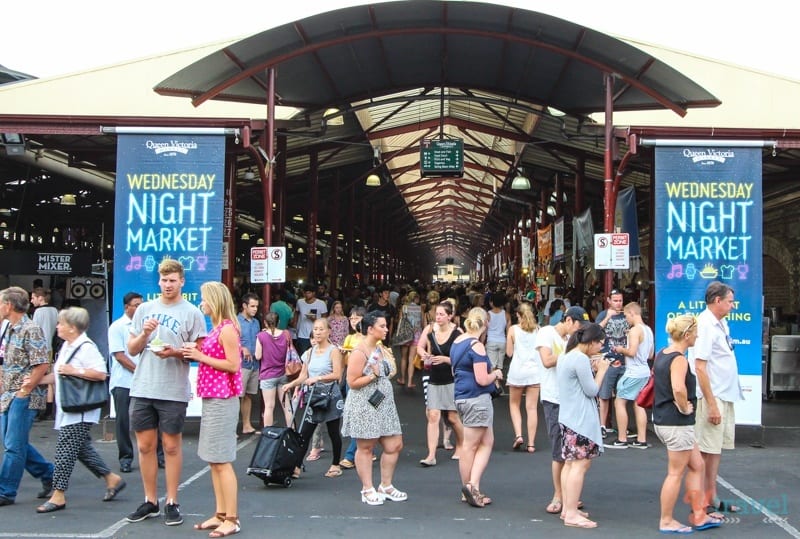
Every major city and regional area has a market. You won’t get the food and souvenir prices you’ll get in Asia but a trip to the markets is still a cost effective way to eat, shop for clothes, and buy some nick knacks.
Melbourne is a food lovers paradise and the Queen Victoria Market is fantastic, especially the Wednesday night market.
In Adelaide don’t miss the Adelaide Central Market and Hobart has their famous Salamanca Markets.
In Cairns, Rusty’s Market is an icon up there and was a great place to get our fruit and vegetables ad we loved our hometown Burleigh Farmers Markets. The Eumundi Markets on the Sunshine Coast and the Bellingin Markets near Coffs Harbour are two of the best markets in Australia!
Seek out the markets wherever you go to stock up on your food supplies and they’re generally a great pace to visit in their own right.
Get Free Entry to Museums & Galleries
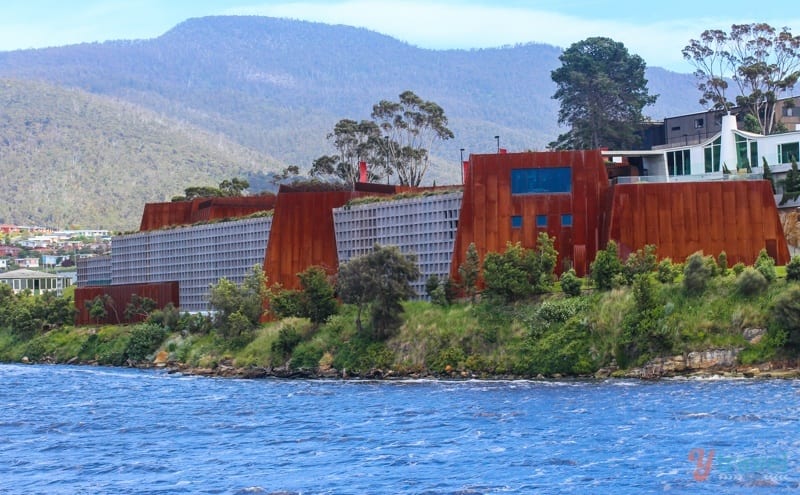
If museums and galleries are your thing, visit the particular website and find out which day or time of day they have free entry. Most museums and galleries have certain periods where entry price is free.
For example in Sydney the Art Gallery of NSW is free to enter and is one of Australia’s leading art museums with collections of Australian, Aboriginal, European, Asian and contemporary art.
Although we do recommend paying $20 to see the M.O.N.A museum in Hobart – amazeballs.
See the Wildlife in Australia on a Road Trip
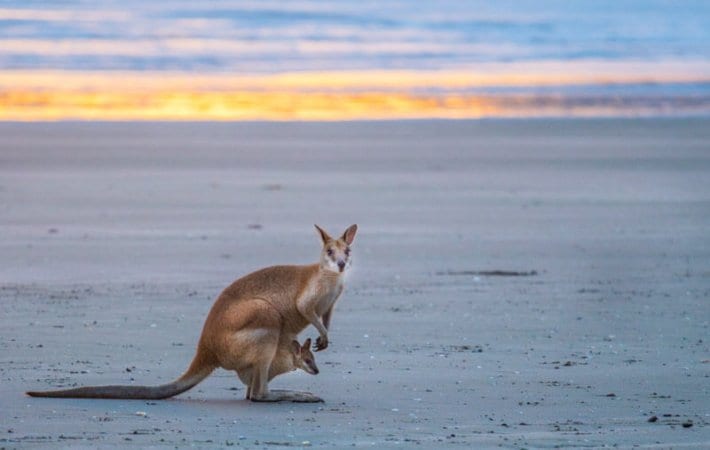
Entry prices to zoos and wildlife parks can be a bit pricey in Australia. Fortunately if you’re on a road trip there’s a good chance of seeing the Aussie wildlife for free in the wild, and naturally it’s the best place to see them!
- Head down to places like Pebbly Beach on the NSW South Coast where you’ll have kangaroos running wild on the beach. You can also see them on Lucky Bay Esperance in Western Australia and Cape Hillsborough near Mackay in Queensland.
- Carnarvon Gorge in Queensland was the best place to see kangaroos that we discovered on our Australia travels. Here are more places to see kangaroos in the wild.
- Koalas can be spotted on the Great Ocean Road in Victoria and on Magnetic Island in Queensland.
- Wombats and echidnas can easily be spotted in Tasmania and Kangaroo Valley in NSW.
- Fraser Island and Kangaroo Island are two of the best places in Australia to see wildlife.
- And of course, for marine life, don’t miss the Great Barrier Reef and Ningaloo Reef
If you don’t have the time or the means to get out of the city and want to see some Aussie wildlife, Sydney’s Taronga Zoo is world class with probably the best views of any zoo.
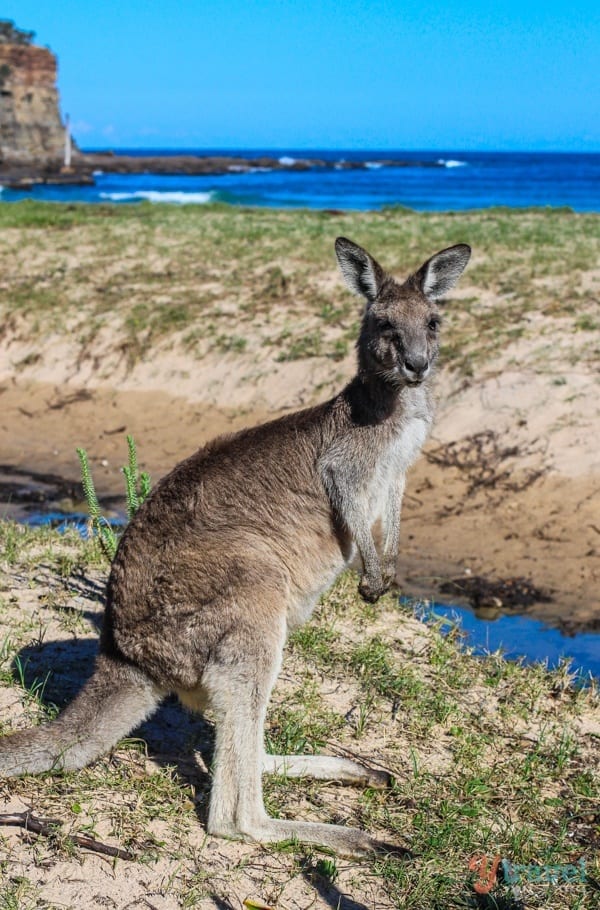
Take Free Walking Tours in Australia
The guys from I’m Free Walking Tours offer free guided walks in Sydney and Melbourne twice daily.
The 3-hour easy walking tours will show you the sights and give you your bearings so you can then go it alone.
These walks are a great introduction and the knowledgeable guides work for tips only.
Look Out For Free Festivals & Events
If you can, time your visit to coincide with one of the fantastic festivals or events around the country, many of them for free. It’s a great way to experience some Aussie culture.
One of the best free festivals in Sydney is Vivid Sydney.
For other suggestions check out our guide to the Best Australian Festivals and Events
Look for Low-Cost Tours
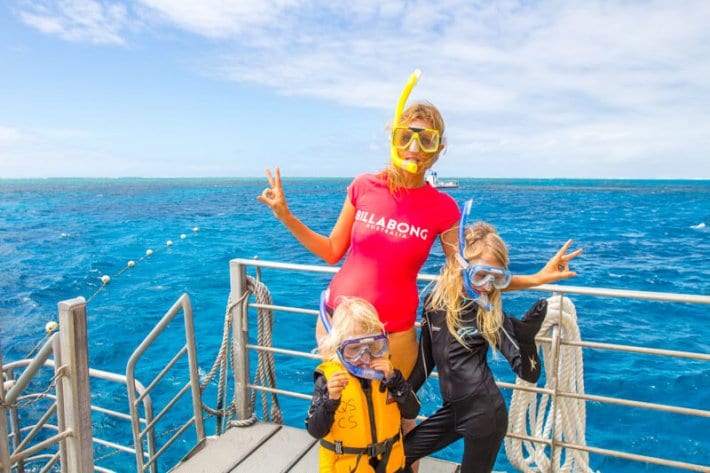
The cost of tours in Australia can be super expensive, so you have to prioritize what tours and attractions you really want to experience.
This could be your once in a lifetime adventure and you don’t want to miss out on your ultimate experiences so put aside some money in your budget for those and sacrifice in other areas of your budget.
Here are some of our favourite tours we recommend putting money aside for (so far!):
- Great Barrier Reef experiences.
- Sydney Harbour Bridge Climb, although you can walk across for free. And make sure you walk around to Mrs. Macquarie’s Chair in the Royal Botanic Gardens for one of the best free views of the bridge and Opera House.
- Port Arthur Historic Site, Tasmania
More Australia Budget Tips
Before you go, here are some other top tips to consider when trying to travel Australia on a budget…
Visit Tourist Information Centres
We always visit the tourist information centres in each city and town we go to.
We like to drop in and get our free maps and chat with the folks behind the counter who can be a great source of local knowledge on how to spend your dollars and time!
Make it a Working Holiday
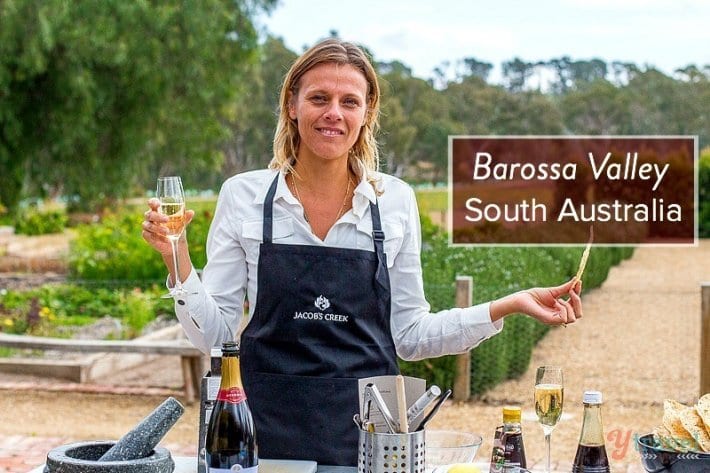
Consider working in Australia. Although the cost of travel (and living) is high, you can offset that by working in the country on a working holiday visa and saving some dollars for travel.
Agricultural, fruit picking and wine harvesting provides excellent opportunities for you to work in exchange for food an accommodation and often times extra cash.
We’ve seen plenty of signs advertising free accommodation in exchange for a couple of hours work a day in hostels.
To live and work in the country can be a cost effective way to experience Australia over the long-term.
The Easy Way to Work and Travel Australia
Global Work & Travel is the youth travel platform that connects travelers with opportunities to work & fund their travels abroad through cultural exchange experiences like working holiday, volunteering, au pair, study abroad, teaching and internships.
EXCLUSIVE DEAL: Just for our readers: $100 off your trip (whatever your currency) You must use the code: YTRAVEL. Learn more and use Discount
Go To Coffee Shops For Internet in Australia
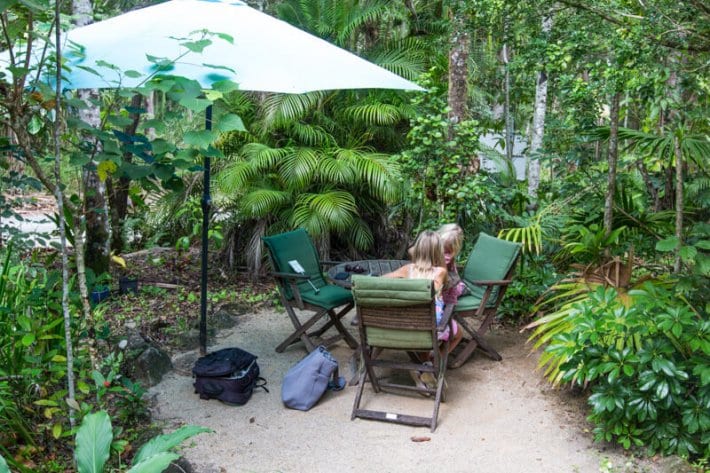
Not only is internet in Australia stupidly expensive, it is also hugely unreliable and away from the capital cities can be very slow.
It’s a constant struggle for us as we road trip around the country, particularly in the country regions and the Outback.
Our phones are with the Optus network and once we left the east coast, we barely had service.
Try libraries, cafes, hostels and McDonald’s for free wi-fi hot spots to check your email from your smart phone or laptop. If it is free, don’t expect it to work that well. And rarely will it be fast especially in congested areas.
Urban Spoon is a good resource to search cafes and restaurants offering free wireless.
You can buy mobile wifi devices for your own laptop to connect to the internet. You can pay-as-you-go which could be a cheaper alternative then buying internet connection at hotels or hostels.
You can buy a cheap SIM card for your phone from the supermarket or phone store. You can then pay as you go. Even better is to purchase an eSim – if you have an unlocked phone. Our favorite company to recommend for ease and best prices is Airalo. Click here to see rates
Only top up when you visit outside the cities so you can use it in rural areas for navigation, whereas in the city you can connect to WiFi and save your data for when you really need it.
Telstra is the fastest with the best network (which they abuse with high prices). Optus is the next best – they have better customer service than Telstra but Telstra has the better coverage.
Ensure you protect your data and privacy with a VPN if using free wifi. Read more about that here.
Tours of Australia
If you were looking for group tour options in Australia, rather than traveling independent. Our preferred partner Globus has a range of Australian tours. Click links below and be sure to use our exclusive code in the blue box below.
- See all Globus Australia tours here
- See all Cosmos tours here (part of the Globus brand)
GLOBUS DISCOUNT JUST FOR YOU!
We’ve secured an exclusive yTravel discount: Save $100 per person on select 2024 Globus and Avalon Waterway Vacations. Use the code: YTRAVEL when booking online at the Globus, Cosmos, and Avalon Waterways websites, by calling Globus and Avalon Waterways directly, or booking with a preferred Travel Advisor. Terms & Conditions.
Final Thoughts on How to Visit Australia on a Budget
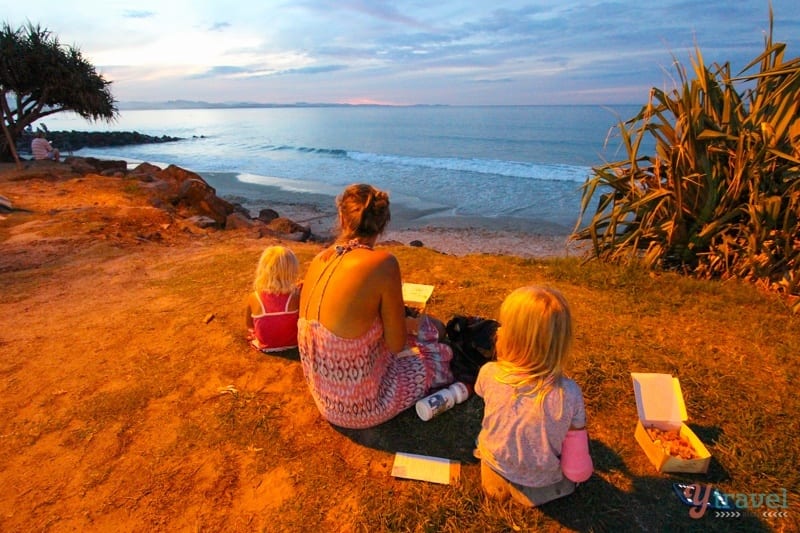
Because Australia is fairly isolated from most of the world requiring a long flight, for many people it becomes a once-in-a-lifetime trip.
Our number one budget tip is always “spend more time in fewer places”.
We highly recommend instead of racing from one end of the country to another, which leads to burnout and a bigger required budget, focus on one region or type of vacation.
If you plan carefully, research thoroughly, and make smart spending choices, you can have that dream trip and experience Australia on a budget.
It’s a country that is really worth planting your feet on for a while.
We’ve created a page with all of our favorite travel booking sites and resources when you’re ready to book your trip to Australia! It will help save you time and money.
Save It On Pinterest
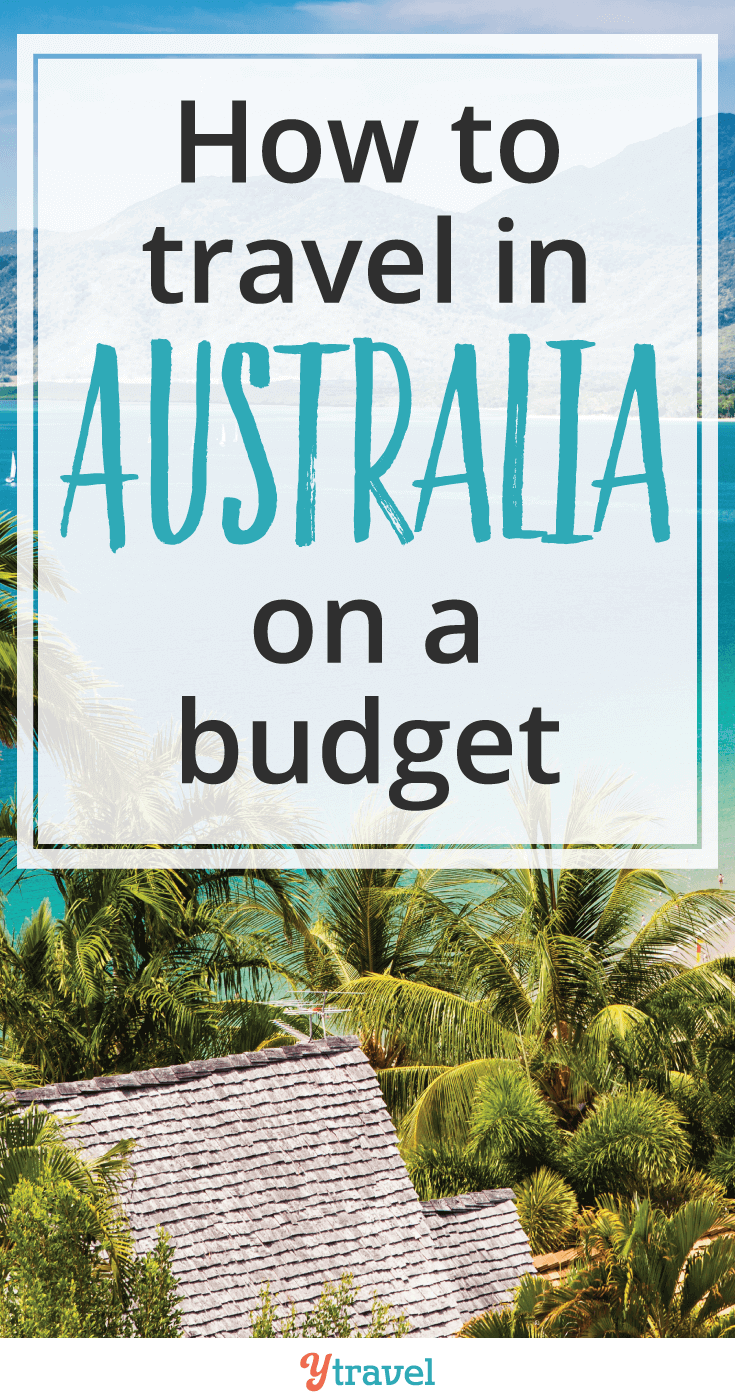
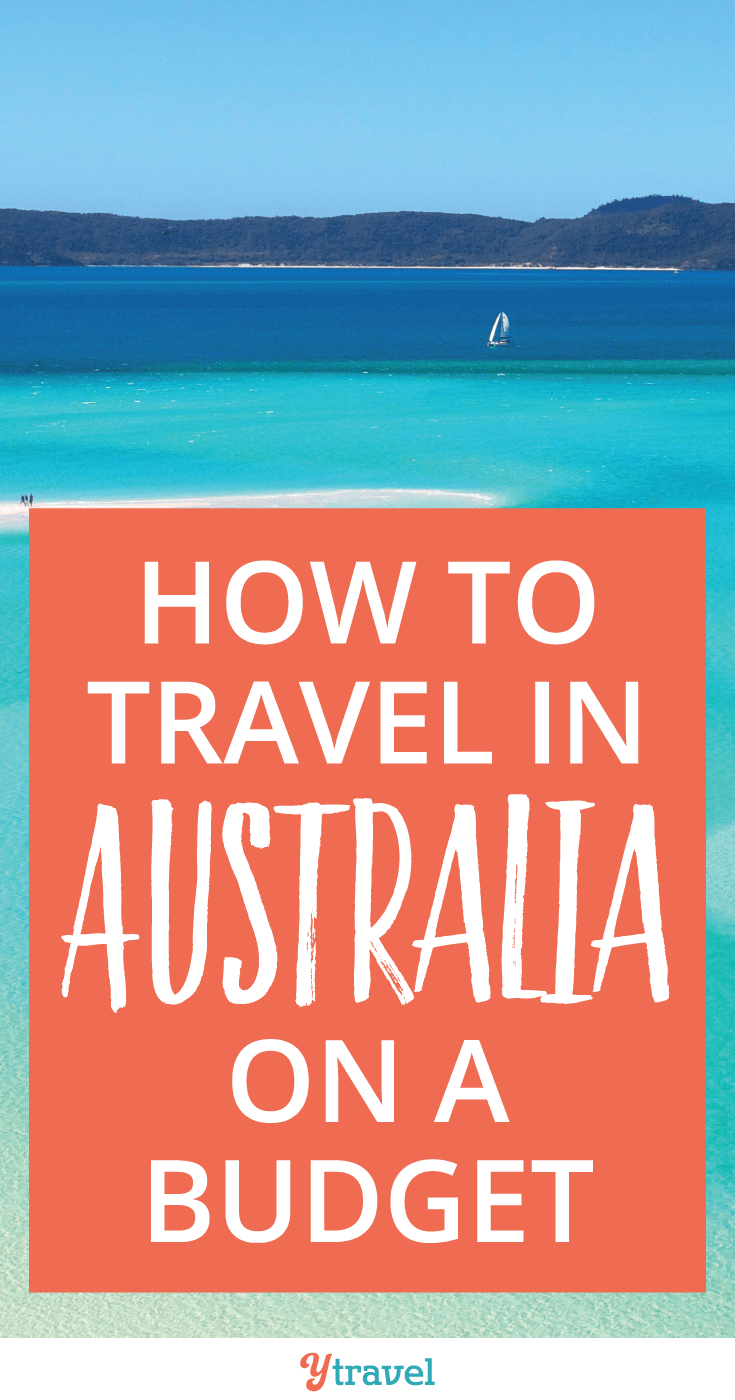
What was your budget for traveling in Australia? Let us know in the comments!
Hey Caz & Craig,
wow, super in-depth article! Well done!
I’m currently traveling in Australia, too, so I stopped by to check out your budget tips. I’ve found mostly the same as what you’ve recommended here. In fact, I can’t really think of anything to add to this. …oh, except maybe for work exchange programs, like HelpX and WWOOF, in addition to working holidays.
Excellent post for any budget travelers heading to Oz! Enjoy the rest of your trip.
cheers, Lash
Have heard good things about Helpx and Wwoofing. Thanks for reminding me Lash. Hope you continue to enjoy your Oz travels!
Fantastic article guys particularly because I’m here right now!! 🙂
I definitely agree with using YHAs – I HATE party hostels so whilst they’re a bit more expensive than a young backpacker might like, I love the fact that you can meet new people but they’re cleaner, calmer and better serviced 🙂
Yeah YHA’s are great value Toni. Don’t get me wrong, we used to party with the best of them in all types of backpackers hostels. But I can’t do dorms anymore, not with 2 young kids, unless we have a 4 bed dorm to ourselves!
This is an awesome guide! The free camping in Australia is one of the best things about traveling through here – so handy to have a place to sleep and free BBQs!
Yes we plan on doing more free camping as we travel through the Northern Territory and Western Australia. The only problem for us is lack of internet in those places, and going too long without showers, toilets and washing clothes does become a little difficult after a while with the kids.
Thanks for all the useful information. Our biggest spendings are on diesel and it’s really hard to safe on that part. Because we do not want to see less just because of the fuel costs. But good to know that it is the cheapest to fill up on Tuesdays & Wednesdays. We didn’t know that. Great tip. Cool, it’s Wednesday today… on the way to get some diesel 🙂
Happy travelling to the four of you.
Hey Reni, we have spent a lot on fuel the past 2 weeks traveling from Cairns to Katherine in the NT. But as you say, it’s all part of it and you have to budget for it. And fuel prices vary from place to place. Hope we see you on the road again!
This is gold dust for backpackers like us. Coincidentally, I was planning a trip to Oz next month and flights were becoming quite a hindrance. It seems I would have to be flexible on that count.
Regards,
Bhavya
Flexibility is huge with finding flight deals!
Great comprehensive article, Caz & Craig! We are currently in the Northern Territory as well, after 4 months in WA. The free camping sites are a LIFE saver to us…especially as Australia HAS proven to be more expensive than we anticipated. I think the shocker was the price of petrol, and the seemingly small size of our campervan fuel tank haha! we go through a lot of fuel every day. We’ve used Aussie House Sitters–great resource and awesome when you’re on a tight budget, but you’re correct that it is very competitive to get a house sit! I also agree with a previous commenter that Workaway and HelpX are awesome, as well as WWOOFing.
Great tips! hope to run into you in the Top End! 😀
Yeah, we are forever filling up with fuel too. A lot of long drives in the NT and at $1.95 per litre it’s a big chunk out of the budget.
Glad you’ve found some house sits. We had no luck in Vic and Tassie. Yep, might see you on the road!
This is the most comprehensive and informative budget travel article I have ever seen. Fabulous job! You haven’t missed a thing.
Thank you Kathy hope it helps!
WOW! This was a lot of information!! Great tips! I think you practically covered everything. I can’t wait to be back in Australia one day and relive my childhood memories from when I lived there. Not that it’s going to happen any time soon!! But if it does I’ll be keeping an eye on this post.
Thank you for the post. This is useful. I had not considered Australia because of the cost. This has made me change my mind.
Glad to hear that Steve!
Thank you so much for this wonderful blog. It has been always my dream to visit Australia, especially Great Barrier Reef and Uluru. I want to ask if there is any possibility to get cheaper flights to Uluru than what I found ( prices around $800-$900 from Sydney and back). Do you have any useful tips on how to travel to Uluru for less?
I’ll be definitely reading your blog so that I can plan my Australia trip next summer.
Cheers!
Veronika
Unfortunately no. There are only limited flights that go to Uluru which is why the price is so high. Unless you find someone to share a car ride with – but it is a long drive from Sydney! Maybe look at tour options in case you find one that works out a better deal than flying.
Hey guys.
Long time reader, first time commenter.
Thanks for linking to all those cheap flight resources. I’ve always been a fan of Skyscanner myself and have never heard of some of the other sites.
P.S. I think the Webjet link is broken
Great in depth article! We live in Australia and learnt a few things from this! Definitely a +1 from me for MONA in Hobart. The unfortunate thing about Australia is really that everything is really really far apart. While the cost of fuel is quite high here I think its pretty much essential to have a car to get around on the east coast. Even with just 2 adults sharing costs, the fuel cost ends up being cheaper and WAY more convenient than the buses. AND you get to go find hidden gems on the south coast like the lorikeets and kangaroos at Pebbly Beach or the white sands of Hyams Beach in Jervis Bay. Really love your blog! All the best, Amy.
Oh, I will surely be revising this post next year when I MOVE to Australia! I can’t wait. I’ll be getting a working holiday visa (I know your post on this already too!) and of course traveling in-between. I’m a bit scared bc I have been living in dirty cheap SE Asia for three years, four years by the time I get there! But… I know it will be fine 🙂 Thank for this post!
What an excellent and comprehensive post! I’m am hoping to put Australia on my upcoming travel list, but the high expenses have been discouraging until now. I’m so glad to hear that it’s possible to visit without breaking the bank. Thanks so much!
I came across your website while i am digging out OZ information. You guys are awesome and I really love it. I started travel abroad when I was 24 (last year) and Bali is my first destination. And then I went to UK for a short trip two months later and now, I would love to visit OZ. I am thinking of Tasmania. Reading your post really inspiring me to keep on dreaming and believe that I could achieve it. I am freelance graphic designer, I don’t earn much but that’s all I can do for living. I wish to make the world as my home too. Oh, I am a girl from Malaysia. Do visit my state, Kedah. It have a beautiful island, Langkawi Island.
p/s: Bad English, sorry 😛
Hi! Your blog is essential reading, not least for first time travelers to Australia. I’ve been returning to it several times during the preparation for the big trip, so thank you very much! I’d like to add one idea for young people on a tight budget, especially those who are still studying. By getting an International Student Identity Card (ISIC), they can get access to many 20% discounts on restaurant food in major Australian cities (among other benefits). It’s a really cool thing and with a little planning ahead, can save you a lot of money.
Thanks and continue with the great blog!
Nadia
Thank you! Very helpful!
We also planing to go at Australia, please share low cost hotels and decent travel location
Travelling gives me great pleasure, which is why I have been all over the world but nothing is compared to what I have seen in Australia. If you love travelling as well, go there with http://www.travelaust.com.au
This is a great read. It’s so thorough and helpful. I CAN’T WAIT to start planning my trip. Thank you for all the tips, tricks, and links!
Your welcome. Australia needs exploring 🙂
To caz and craig,you have done a great post on how to travel australia on a budget.When me and my family go away we always stay in a self contained place so we can cook cheap and easy light meals and only eat out some times.We tend to travel in low season or shoulder season.We tend to avoid holidaying during Christmas time because accomodation is rather dear.We love travelling Oz and will continue to do so.
Hi,
Just wanted to say quickly that that was a really great post and that I love the layout of your website, it’s great!
You’re link above, to your “working in Australia” page is broken, it’s throwing a 404. And now for the shameless plug, if you (or anyone reading these comments) are looking for further information about work and travel in Australia you can check out my website at http://www.downundr.com (although it’s not as pretty as your site!)
And a quick typo I also found: as ‘bore water’ as it‟s not safe (notice the it‟s).
Keep up the great blog guys!
Some greta tips in there guys – Australia is a bit on the pricey side these days compared with the likes of Asia but still heaps of fun and well worth visiting!
What a pity that your blog makes no reference to the National Capital of Australia. ALL the museums (including the Australian War Memorial) and art galleries in Canberra are free and are open all year with the exception of Christmas Day and Easter Sunday, as is the Federal Parliament House. Food wise, there is a wide range and diverse cuisine because of the influence of the Diplomatic/ Embassies represented in Canberra. Prices are generally reasonable except in the top restaurants and the cheapest meals are at the many Football Clubs scattered around the city. Accommodation for the budget minded (Backpackers, YHA) is also readily available. Travel from Sydney to Canberra is as little as $15 one way by bus (Murrays). Travellers should visit “visitcanberra.com.au” for additional information including dates of the many festivals/ events held (including Floriade) throughout the year.
Thanks for sharing your tips Kathy. We haven’t been to Canberra so can’t comment on it. Glad you could share it with us
Thank you so much for wonderful post.This is really useful.
Active Networking Components
Hello,
I really loved your post! It held a lot of very useful information and great tips. Most helpful I have read yet.
I am arriving in Sydney in April 2017 and taking a 30 day cruise from there to Los Angeles, CA. I would like to do more than fly into Sydney and board my cruise ship. I am retired so my time is flexible, but I must travel on a budget. If I arrive 3 or 4 days before my cruise departure, what places on the East Coast are must see destinations? I am 71 years old, so strenuous outdoor excursions are no longer possible.
There wouldn’t be too much you could and see in that time frame as distances to travel to places wouldn’t make it worth it. You could spend that time exploring Sydney. There is much to see. Or you could head inland to the Blue Mountains.
Great overview of the trip. I can really see the beauty of the place. Excited in getting there soon.
Australia is known for many things — extraordinary landscapes, laid-back cities, beautiful beaches. Bondi Beach is one of the best.
Fantastic tips, guys! 🙂 I wish I had known about Rex Airlines. Next time I find myself in Australia and doing some ‘off the beaten path’ travel, I will look into getting the backpacker pass… 😀
Cool. See you back in Oz some time!
This is soo informative. Thanks so much for all the detail. I really want to do this one day!
Well written article and very helpful.
What a great post! Thank you.
We are traveling from Cape Town, South Africa in June and the Rand is incredibly weak at the moment. This post is so helpful!
Much thanks for this comprehensive article. covers more practical aspects of traveling australia. keep up teh good work !!
Happy to help guys. Thanks for reading!
good post
Wow, thank you for all the info in the article, we are looking forward to using your tips on our Australian adventure.
Glad to help guys! Enjoy your time in OZ!
Two weeks in Tasmania went past fast. We were scared of the worst but true to be said, it was not too expensive. Provided you do not eat our, have a car and only buy in supermarkets, you can spend as little as in SE Asia!
Great topic, Craig! There is no place like Australia! Only in Australia, can you experience the diversity of deserts, mountains, beaches, rainforests, alongside hip modern metropolises that are constantly being ranked as the most liveable and enjoyable cities in the world. It’s this variety of activities, sights, and attractions that make Australia so appealing for all types of travellers, from families looking for fun in the sun, to singles looking for adventures, and everyone in between!
I really disagree with a lot of this article. I travelled Australia for three months with a car and went from Adelaide all the way to Cairns. Maybe it’s because I’m from the UK but it’s definitely more expensive than there! Interesting fact – I spent more in Thailand than I did in Australia! If you are sensible with your money, you won’t be out of pocket soon here. I had the most amazing time, didn’t miss anything out, and was way under budget – and I still had ten months of travel left!
I’m a little confused with your comment. What are you disagreeing with and are you saying Oz is more expensive than the Uk? It sounds like you are,which I’d agree with but it doesn’t really suit the rest of your comment so I’m totally confused. This post actually says that Australia is expensive, but we offer tips on how to do it as cheap as you can. I’m not sure what you’re disagreeing with as it’s not really an opinion piece.
We travelled around Australia for 18 months + we are Australian and have travelled to many other countries. Thailand is more expensive now than when I backpacked there man years ago, but it is not more expensive than Australia, particularly if you travel like a local there. Australia is expensive, but you can do it cheaply. Don’t forget, it all depends on how you choose to travel as well. Not everyone wants to be a backpacker.
Craig,
I recently bought a ticket to Sydney and your post is super helpful! Thank you for all of the tidbits and information and I am reading all the good stuff you have on this great travel blog.
Thank you!
Happy we could help Albert. Enjoy OZ!
We have a couple of months left in Australia so this has put our priorities straight in regards to where we will into our check list. Thank you for this detailed post!
Beth & Sam
Travelling to Australie would be one of my biggest dreams… Working in an events promotion company, I get to meet a lot of people, and some have told me they already travelled to Australia but always warned me about the price of such a trip. I have never dared to calculate the costs, but maybe with your article I’ll figure out how to achieve my dream.
Valentin @ jorlio
Hello! Lovedddd the article! I have a question though… don’t know if you are able to answer it!
Supose a tend to travel through OZ on the very lowest budget there is (backpacker style, free camping, etc), and bring along with me about AU$ 5,000…. how long do you think it could last, in terms of months? You think that I could reach 6 or more? I know its hard to say, but you seem to be the best person to try answering this enourmous doubt I have lol. Thankss 🙂
Hello Craig
You have shared wonderful information with all of us. I am looking for travelling in Australia from long time. Budget traveling can be fun and exciting if it is chosen according to planning. There are many ways to make a budget vacation special. It provides great benefits and less expensive for all popular destinations.
Thanks for sharing this great post!!!
Your welcome Katherine. Hope you enjoy lots of travel within Australia!
Fantastic article! great read.
Something you might be interested in if your travelling to Brisbane. I’ve recently set up a forum for Brisbane and it would be an awesome tool for anyone travelling to Brisbane looking for general advice & questions. You’ll be onboard with all the Brisbane locals so you’ll get great advice about the City, trips to Moreton Bay, Stradbroke Island etc. Take a look at our community forum http://www.brisbaneforum.com.au
Keep up the awesome Blog!
Olivia
Really impressive travel information you share.Thanks for giving such knowledge.
Travelling always gives huge enjoyment for all. I cover all over the world but nothing is compare to what I have seen in Australia. If you love travelling as fine, then you go for the best travel site.
WOW!!!! Very informative! Thank you SO much!!
Travelling gives me huge enjoyment, which is why I have been all more than the world but not anything is compare to what I have seen in Australia. If you feel affection for travelling as well.
Great review thanks! Going to Australia in December to dive for the first time. All this positive info has me super excited, cheers!
Amazing article. It made me feel as if I am on tour. In depth details with images. Thats how one should write a travel blog. Very informative thank you very much 🙂
I love this post! It’s super helpful and gives great advice for first-time travelers. I’m re-posting this to my website to share with my readers.
Glad you found our tips on how to travel in Australia on a budget useful. Hope you get to visit Oz soon!
I am traveling to Perth from India for 2 weeks. We are 3 people I.e. 2 adults and 1 kid. Our accommodation is sorted out. Can someone who is a regular traveler suggest what kind of amount should I carry which will be fair enough for two weeks. We will also have a layover at KL. So what kind of amount breakup would be ideal?
I am planning 30K INR conversion to AUD and some to ringgits for layover at KL airport. Besides that I will be carrying about 20K INR.
I was also suggested by someone to convert INR to US Dollars for the travel. Can anyone suggest how does that help in Australia?
We might travel to Sydney or Melbourne. But as of now i need a fair idea only for Perth travel. Its very confusing for me as I am traveling for the first time outside India.
Last month I with my friends traveled to Australia. And we rented a car for a weekend.
The chaps at Star Airport Parking are brilliant to deal with.
Not only were the fees brilliant, but the service they provide, excellent. They staff were super polite to other customers that were being a little difficult, and nothing but courteous and professional.
I have no hesitation recommending them. Brilliant.
Who’s the Boss? – these guys are http://www.starairportparking.com.au
Awesome article. LOVE to read this article truly helpful.
I am love to visit here next time.
Thank you very much for helpful post and tips
Your welcome Diane, hope you get to travel in Australia soon!
Hi there,
I’m from Ontario, Canada. I plan to go on a 14 day tour in February to my bucket list Australia. Now I know that this time is very limited and there is too much to see and do in this time, but I’m going anyway! I’ll be flying into Melbourne and I have a family friend picking me up. From there, I’m not sure what I’d like to see first. I’m looking for national parks; Uluru park being #1 of course… I’d like to tour the ocean road, see wildlife and maybe take a (guided) walkabout. My question is; should I drive? Should I fly? Best options for sleep? It’s just me on my own, husband worries that I’ll risk it by sleeping in my car, so he needs to know that I’m taking safer precautions… (he says I have wild child syndrome). Can you help me out on how to properly plan this trip that doesn’t make me sit in airports or spend too much time driving? I hope I’m bringing enough money too. $4 grand should be ok for 14 days? Just curious. Thanks in advance for any help
Hi Lisa,
That’s great you’re coming to Oz. From Melbourne, you can easily drive the Great Ocean Road. We did it over 2 weeks but you can see the highlights over 2 days. Check out these two posts on the GOR:
16 highlights of the GOR: https://www.ytravelblog.com/the-great-ocean-road-australia/
5 towns to visit along the GOR: https://www.ytravelblog.com/5-towns-visit-along-great-ocean-road/
Where to stay on the GOR: https://www.ytravelblog.com/great-ocean-road-accommodation-yha-apollo-bay/
An awesome National Park 3 hours from Melbourne is Wilsons Promontory NP. Great hiking and beaches, but limited accommodation and you’ll need to book ahead. Here is our post: https://www.ytravelblog.com/wtf-heard-wilsons-promontory-national-park/
As for Uluru, you will need to fly there from Melbourne. It’s too far when you only have 14 days total. Here is our post on Uluru: https://www.ytravelblog.com/uluru-ayers-rock/
For Melbourne, check out these tips: https://www.ytravelblog.com/what-to-do-in-melbourne-australia/
And here is our 3 week itinerary for Australia: https://www.ytravelblog.com/visit-australia-itinerary-3-weeks/
Hope this all helps. Have a great time 🙂
Wonderful write up! This will definitely help a lot, I’m glad you have identified several options for getting around Australia. The tips are also on point!
Your welcome Agness. Hope it helps you for when you travel in Australia
Hi Caz and Craig,
I love this article. When I was travelling through Australia I was actually using some the advices that you guys mention here as well 🙂 I mainly tried to save money on accommodation costs. So I slept in a car most of the time.
I actually write run a travel blog as well – http://volleontour.com/ – where I write about Australia. It is a really big part, because I really love this country. When I go back I will use your recommendations as well. Always good to learn something new 😀
cheers
Christian “Volle” Vollmert
Hi,
thanks for your very in-depth article!
I recently wrote a blog post about traveling Australia’s west coast.
If anyone is interested in reasons WHY you should see the beautiful west coast, you can read it here: http://wp.me/p8wLK7-1t
xo
Wow, your post is really great! I love your pictures, what camera did you use? Travelling on a budget in Australia can be very difficult, especially in big cities like Sydney or Melbourne. I first arrived here on a working holiday visa and I have to say it was tough at first, but not impossible! I managed to survive and to even find a sponsor to stay here for good:) I wrote an article about finding jobs when you’re a working holiday maker or backpacker, I hope you find it interesting: http://www.myjobinaustralia.com/how-to-find-a-working-holiday-job-or-backpacker-job-in-australia/
Thanks for all the useful information.
This is an awesome guide! The free camping in Australia is one of the best things about traveling
Great information, I’ll be visiting there next week.Thank you for preparing me in advance.
Thanks for the tips! Planning to drive to Perth next year and this would be so useful!
Sure thing Arnold. You can read more of our Australia tips here: https://www.ytravelblog.com/best-australia-travel-tips/
This is a really great article! Thanks for sharing these tips. Australia is such a beautiful country to visit. It offers some of the most affordable accommodations to relax and spend time with your loved ones.
Hi Caz and Craig!Thanks for these awesome tips! It’s really hard to do budgeting when you want to see and experience different things and of course to taste as many local foods as you can.
That’s cool. There’s so much to do in Australia. I’ll be coming to the country soon and will be staying at The Ville. It’s an amazing hotel. We’re gonna be there for a short while. Hope to have a great time in Australia.
Hi,
The pictures you took look absolutely fantastic! You’re a very cute family, and these images remind me of my own whv in Australia. These were good times… Now I’m back in the UK, and I have to confess I feel a bit depressed… I wish I could go back to Oz, so thank you for these amazing pictures of Australia, they brightened my day!
Looking forward to reading your new articles!
I hope you can find a way back Alice! I know that feeling
Great article, thanks for the tips! Also known as the land down under, Australia is renowned for the pristine beauty of its natural wonders and is a joy to visit. However, there are numerous tourist targeted scams to be wary of. http://travelscams.org/oceania/common-tourist-scams-australia/
Do be wary of the discounted tickets bought by stolen credit cards, rogue tour operators, pub crawl organization scam, fake monks, Mildura fruit picking scam, tax free outlets scam, forced purchase scam and many more!
Nice post for travel to Australia with your budget. The post practically covered everything. If you look different offers then it will also come in your budget. Mainly for staying, food and transportation are very much important on your every trip. This new year I was on my first Australia and Singapore trip with my wife and spend my holiday. We used the Goflyal offer for staying in luxury Expedia hotel. Also used some other sources for the journey within our budget. Really It’s a great place.
Awesome guide. In order for your travel in Australia to be cheap, you need to plan everything you’re going to do and take every budget wise way possible ex. public transportation, cheap dinners, etc..
Thanks for your very interesting post about travel in Australia.
I’m an Aussie born and bred peeps, Living in Melbourne CBD. Look into “Wicked Campers”. They are little cheap vans that you can travel and sleep in. But you can’t just pull up on the side of the road here, especially along places like the great ocean rd. Its illegal. You’ll need to book into a caravan park and take advantage of the hot showers and power. Be careful about free camping, see “Wolf creek” the movie. Yes it does happen unfortunately especially in the remote country areas
We don’t recommend Wicked Campers – they have appalling messages on their vans
This is so great- I stumbled upon this just in time for my year-end vacation plans have started. I am torn between Australia and New Zealand (hoping to catch the Flight of the Conchords there) and there’s enough information for me to decide. The only concern I have is about the visa. Do you have any more info about getting visas for me and my family. I do not want to go through a travel agent because they are vultures. I’d rather go through the “red tape” myself than get involved with an agency. Tips? I’m from India, btw. Thanks a lot.!
We don’t know too much about visas. It’s so different for everyone depending on many factors. It’s best that you reach out to your local embassy to ask them
Hi Caz and Craig.
Thank you for your inspiring article. I’m studying in Australia. I feel very motivated after reading your article, will plan for a trip around OZ end of this year.
Cheers,
Lesley
I have thoroughly enjoyed reading your information and tips. What I haven’t found yet, is information on internet. I recently was in China only to find that they do not have Google or any related sites. Is there a specific search engine or programs you would recommend?
Jean
Ontario, Canada
The internet works exactly as it does anywhere else in the world (except for China because it blocks everything due to its communist regime) You can read more about Australian internet here https://www.ytravelblog.com/pathetic-internet-in-australia/ It’s getting better but still not great.
I love reading all of your articles. They have helped me and my partner so much for planning our holidays. Keep up the good work.
So great to know. Thank you for letting us know.
Hi,
I went to Sydney and saw all the amazing places like Sydney tower, Queen Victoria Building, Blue Mountains etc. I just loved the places and also I made some new friends and also got along with some of the locals. I recommend other people as well to go and visit these places. And thanks for telling us about the “Family Funday Sunday” next time I will take benefit from this if I go with my family.
Glad you enjoyed Sydney Terry. I’m guessing they still have the Family Funday Sunday but it’s been a long time since we’ve been in the city.
we ( 2 family with 7-8 members) plan to drive travel from Sydney to Ade lade) within 12 days, please recommend the road trip.
Thanks,
Awesome!! That looks so dreamy, Unreal ! I am packing my suitcase for Sicily and I’m really hoping to get some gems of experiences and photos as good as yours. Incredible Australia!
Thanks for all the great tips! Australia has been on my bucket list for years. We’re planning on visiting within the next year so still in the initial stages of planning. Your article definitely helps to make it a lot less overwhelming. I will definitely be coming back for more tips as I dive further into the planning of our trip. Appreciate all the help!
This is a great article. Thank you for all the recommendations!
The other tip that my husband and I have found really helpful is using vehicle/campervan relocations. There are several websites, but my favorite is https://www.coseats.com/. Basically, it’s a one way rental, for sometimes as little as $1/day (and if you’re lucky, some fuel reimbursement too) to help out a rental car company by returning a vehicle for them. It’s often last minute, but cost effective and really fun if you have a little flexibility, and if it works with your schedule.
My husband and I used a compaervan relation from Darwin to Alice Springs. The van was perfectly stocked with bedding and all cooking equipment. It was convenient and easy to find campgrounds and sleeping in the van was comfortable (and more affordable than hotels). It was a budget-friendly and fun way to travel. And I would definitely do it again!
I currently live in Australia and just a tip regarding drinks: It is cheaper to drink at RSL clubs and Surf clubs …. around $4 a schooner :)
Yes that’s right. I actually am not sure why we didn’t put that in the post as it’s what we regularly do when we live in Australia. Thanks for the nudge
Hello, tanks for your blog. My name is Constanza and I´m from Chile. Australia and my country are very different. For example Australia is much more warmer than Chile. And the culture is different too, Australia have a great diversity of religions, compared to Chile. From Australia there are a couple of things that I especially liked. The Sydeney Oper House, because that was beatiful. Also the Great Barrier Reef Marine Park, because I love the fishes and one can have a lot of fun. As well the Sydney Harbour Bridge, because it’s huge and wonderfull. And finally the Bondi Beach, because I love the water and the beach. I would love to visit this country, and I hope someday to do so because it is a very nice and interesting country, with many things to see and know.
thanks for telling such a great info
Very comprehensive and well researched article! For us budget travel in Australia is possible because we have the time to travel slowly, the set up to free camp as well as store and cook our own foods and we do as much free stuff as we can wherever we go. It’s definitely not a travel life of resorts, flights, restaurants and endless tours but it is still fantastic.
Yes. We loved our 18 months traveling the country doing just that! Very affordable when you go this route and what you see is incredible. Australia really is the country for that kind of travel. It was a very different experience for us doing it in the US.
This is very interesting news for travelers who want to travel to Australia.
Thanks For such a big guide for travel . From romantic couples to families and solo travelers, everyone gathers here each year in plenty.
You are welcome. Hope it helps you travel Australia on the cheap!